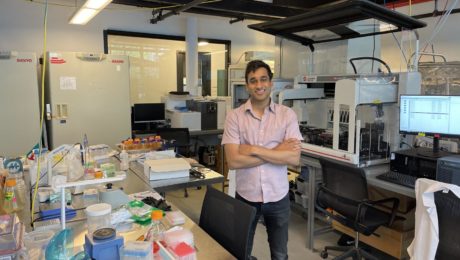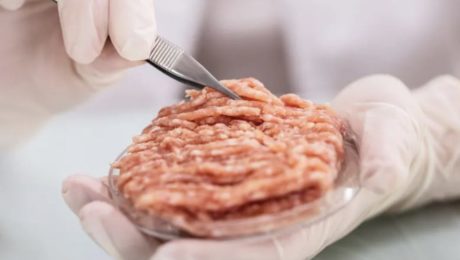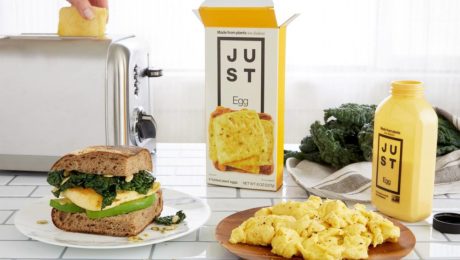Alt Protein Hype Missing Bigger Food Industry Solution
Will alternative proteins save the planet? A report by the International Panel of Experts on Sustainable Food Systems (IPES-Food) says alt proteins – or what they call “lab meat” – aren’t the answer. In a new report, these experts say major reforms need to be put in place to increase biodiversity of food, improve access to better nutrition and limit Big Food’s control over the food system.
Companies, governments and investors are turning to alternative proteins as a way to feed a rapidly growing population but, the panel notes, they don’t address the world hunger crisis.
“In reality they lead us back to the same problems of our industrial food system: giant agribusiness firms, standardized diets and industrial supply chains that harm people and the planet,” announces a video created by IPES-Food. “We need to change the system, not the product.”
Adds Phil Howard, lead author of the report: “It’s easy to see why people would be drawn to the marketing and hype, but meat techno-fixes will not save the planet. In many cases, they will make the problems with our industrial food system worse — fossil fuel dependence, industrial monocultures, pollution, poor work conditions, unhealthy diets, and control by massive corporations. Just as electric cars are not a silver bullet to fix climate change, these solutions are not going to fix our damaging industrial food system..”
The report suggests that, to feed a growing population, the food industry should focus on sustainable food systems, not a transition to alternative proteins. A healthy food system should be regional, nutritious and focused on how real food is produced.
Read more (IPES-FOOD)
- Published in Business
Are Alt Proteins GMO?
America is full speed ahead in the regulation of precision-fermentation-derived food, but Europe has yet to approve its first company. Why the difference?
Alternative protein regulatory expert Hannah Lester (from Amgen Regulatory Consulting) says the precision fermentation landscape is hugely unbalanced between the two regions. The U.S. Food and Drug Administration (FDA) has approved various fermentation-derived products through the “generally regarded as safe” (GRAS) distinction.
The European Food Safety Authority (EFSA), though, says proteins made using precision fermentation aren’t pure. The EU labels them as genetically modified organisms (GMOs).Alt protein companies disagree with this description.
For example, one of the largest precision-fermented products, Impossible Burger, was required to submit a GMO dossier to the EFSA. Lester says labeling these products as GMO has become “highly political” and is full of gray areas.. She adds that both areas will face pushback on how precision fermentation products are named.
“There is going to be opposition about what we call these products,” Lester says. “There may be a battle ahead with the traditional farming stakeholders and more conservative member states who have their own agenda and want us to call these proteins derived by precision fermentation [something else].”
Read more (Food Navigator)
- Published in Business
Do Alt Protein Brands Tarnish Food Shows?
Does allowing alternative protein or bio-tech brands into Natural Products Expo West distort the natural foods industry? An article in Forbes argues that the show producers’ decision to allow lab-created, animal-free products into this year’s event is “troubling,” “confusing” and “harmful.”
Expo West has long been the “it” show for established and startup companies in the natural and organic products industry. Forbes says allowing an alternative dairy brand to exhibit next to a legitimate plant-based product that uses organic ingredients is hurting higher-quality brands, “especially when biotech brands are claiming to be superior to plant-based, even as they attempt to co-opt plant-based messaging, as some do.”
Read more (Forbes)
- Published in Business
Microbial Farmers
An article in Modern Farmer highlights “the new generation of microbial farmers,” scientists using microbes to replace chemical additives in food.
At Kingdom Supercultures, co-founders Ravi Sheth (pictured) and Kendall Dabaghi have developed natural microbial strains that mimic additives “instead of having a library of artificial chemicals.” Scientists at the company use machine learning to explore millions of “uncharacterized microbes that live inside fermented food. They extract microbial strains, merge them with other isolates and design what they call ‘supercultures.’”
The end results are healthier compounds with flavors, textures and functional properties similar to their artificial – and less healthy – counterparts. Since the company launched in 2020, they’ve made additives for plant-based cheese and yogurt, vegan personal care products and a vegan butter exclusive to Eleven Madison Park restaurant in New York.
Read more (Modern Farmer)
- Published in Business
What’s In a Name? Label & Ad Errors Could Cost Alt Foods Big
As more companies enter the alternative protein marketplace, and more government leaders debate what should be legally considered meat, dairy and egg products, businesses need to be careful with their product names and label and advertising claims.
“It’s hard to think of anything more important than what you’re going to call the product. However, your freedom of invention is not limitless,” says Ricardo Carvajal,a food regulatory lawyer and director at the law firm Hyman, Phelps & McNamara, P.C. “The name must accurately identify or describe the basic nature of the food or its characterizing properties or ingredients. And this can be trickier than it sounds. What’s the composition of the product? What are its essential attributes? What’s it made from? How’s it made?”
Carvajal spoke on labeling and advertising at the Fermentation-Enabled Alternative Protein Innovation conference. Regulations for the young alternative protein industry are broad and confusing, he pointed out. Alternative foods have not been given a “standard of identity” by the FDA – the legal definition that dictates the composition of a food product, how it’s made and its name. Without formal federal direction regarding alternative foods, legislators across the country are making their own rules.
Governing Alt Food
A majority of states have considered regulating the labeling of alternative food products. So far, 32 states have proposed guidelines, and 15 of those have enacted legislation.
“It’s a bit of a smorgasbord in terms of the content of these state laws,” Carvajal adds. “This is going to remain a difficult issue for companies to navigate. If there’s a standard of identity, a federal law, that’s going to take precedence over state laws. But what we’re seeing is an absence of a federal law or a regulation to cover some of these issues or some of these product categories. That’s leaving the door open for the conventional industry to push for laws at the state level.”
This year the USDA plans to issue guidelines for labeling claims on food products made using animal cell culture technology, which will establish nomenclature and labeling requirements for those alternative proteins. The USDA also plans to provide direction on the labeling of plant-based milk alternatives by June 2022.
Carvajal points to the “soy milk saga” as a cautionary example. Milk is a formal FDA standard of identity, defined as ““the lacteal secretion, practically free of colostrum, obtained by the complete milking of one or more healthy cows.” Plant-based milk brands have been sent warning letters by the FDA, arguing a plant product is misbranded as milk. The soy industry has petitioned the FDA to establish soy milk as a common name, but the dairy industry has lobbied aggressively to enforce preserving traditional dairy product names.
Those FDA warning letters can be a big blow to a company — they’re published on the FDA website, so potential investors and customers can review. Letters are monitored by plaintiff’s lawyers, too. These attorneys specialize in suing companies on behalf of consumers, alleging consumers were misled by false claims. “Those actions can be quite expensive to defend,” Carvajal notes.
“Selecting or devising an appropriate name for a product can be a tricky exercise that requires simultaneous consideration of a number of factors,” he says. “The FDA does not view a name as a marketing opportunity.”
Types of Labeling & Advertising Claims
Though there are no formal legal definitions of alternative foods, alt brands do need to follow FDA, FTC and USDA labeling rules. These regulations include:
- Nutrient content (FDA oversight). A nutrient must have an established daily value to make a particular claim. For example, “Excellent source of protein” on a label requires the product to provide 20% of the recommended daily value of protein, while “Good source of protein” requires only 10-19%.
- Health (FDA oversight). This is a tightly-regulated area, Claims that imply a cause-and-effect relationship between a specific nutrient and a disease or health condition require scientific studies on humans. This research can take years to receive FDA approval.
- Structure/function (FDA/FTC oversight). This is the most popular type of claim on a food label because it doesn’t require review or approval in advance of going to market. Examples here are “Protein helps build strong muscles” and “Promotes a healthy immune system.” Still, a structure/function claim must be substantiated.
- Environmental benefit (FTC oversight). Green claims need to comply with the FTC’s Green Guides, which give guidance on environmental marketing claims. Carvajal advises brands to avoid using terms like “eco-friendly” on a product label or in advertising because “they’re impossible to substantiate.” There are a variety of environmental certifications and seals that are better options for a product label.
- Organic (USDA oversight). Organic food must meet USDA standards through the National Organic Program (NOP). Violations result in costly penalties.
- Natural (no official definition). Natural does not have a legal definition — the FDA permits use of “natural” if the food does not contain anything artificial or synthetic. Meanwhile, the USDA views natural as a minimally processed product with no artificial ingredients, with the determination based on the specific product c rather than a category. Carvajal says a natural claim is a “very high risk” for a brand because “the absence of a legally binding definition has enabled plaintiffs lawyers in a wide range of circumstances.”
“You should assume that virtually any claim that you use on labeling or advertising will be subject to regulation of some kind,” he adds. “The requirements that apply might be general in nature or highly specific. So to protect your business, you should have a formal internal review process to ensure that you properly vet all your claims.”
- Published in Business
2022 Alt Meat Trends & Challenges
“The landscape of cell-cultured meat, and even microbially fermented animal products, is a complicated place where futuristic technology, ethics, the law and business are all approaching the unknown together,” reads a Forbes article.
There are at least 60 companies globally now involved with cell- and fermentation-grown meat, and nearly a billion dollars was invested in the field in 2021 alone.
Animal-free meat, though, is facing growing pains. Forbes shares the trends and challenges in the rapidly-growing alternative protein industry. Some of their predictions and observations:
- Accelerator and incubator programs will help new companies start.
- Startups lead the pack, influencing larger companies to invest in their own animal-free lines.
- Truly animal-free options, as companies develop proprietary methods that don’t require animal input.
- Knowledge sharing, the trend that more companies will not gatekeep their intellectual property.
- Production of all “meats,” rather than just beef and chicken. (Companies are developing animal-free foie gras, fish maw and even zebra.)
- Alt breast milk, using stem cells.
- Cheaper products, as the higher prices of alternative proteins keep some consumers away.
- Regulatory challenges, as regulatory agencies debate terminology and labeling requirements.
Read more (Forbes)
- Published in Business
Are Alt Meat Sales Slowing?
Despite many indications of skyrocketing growth in the plant-based-meat industry, concerns are increasing at the larger, publicly-traded companies. Beyond Meat’s stock price dropped 50% in the last six months. Kellogg’s MorningStar Farms brand and Canadian meat giant Maple Leaf Foods both reported low last-quarter sales for their plant-based divisions.
Analysts in a Food Dive article disagree as to what’s happening. Some point to the fact that the category has shown consistent growth, with the majority of alternative meat products sold by smaller, private companies that do not share sales figures. No one has a clear view of how smaller, startup brands — who pioneered the industry — are doing.
Others, though, say the market is too crowded. Dozens of plant-based products launched this year, and stores only have so much space for these new alternatives. Naysayers suggest that the novelty has worn off – consumers were curious early on, but now aren’t coming back to buy plant-based meat. Alt meat prices are still high and their flavors and textures aren’t as satisfying as with traditional meat.
Read more (Food Dive)
- Published in Business
How Do Alternative Proteins Overcome Their Challenges?
Is carbon the real villain in modern diets? One-third of greenhouse gas emissions come from food production, so companies are turning to technologies like precision fermentation and cell-cultured meat to help create a more sustainable industry. But a transition to alternative proteins won’t be easy.
“The food tech industry has a blind spot,” says John Fasman, U.S. digital editor with The Economist, “they haven’t fully grappled with the fact that food isn’t just fuel, it’s an emotional connection to a lot of people.”
The Economist’s latest cover piece — “Future Food” — explores if and how first-world food systems may adapt. Fasman (who wrote the piece) and Josie Delap (The Economist’s international editor) discussed the business and ethics of alternative proteins in a webinar.
The Conceptual Hurdle of Alt Meat
Though many consumers are adopting flexitarian diets, widespread change isn’t realistic. “Getting people to adjust to their culture expectations of food is a very long task,” Delap adds.
For example, the Thanksgiving turkey or Christmas ham is a holiday tradition consumers aren’t eager to change — and meat substitutes cannot yet deliver. Alternative proteins have come light years from early days of vegetarian “meat” — which was often a flavorless mash of beans and lentils — and now include flavorful and appealing ground meat products. But no one is producing an entire alternative turkey or steak, in which fat, muscle and sinew are layered together.
According to the Good Food Institute, alternative proteins are made by one of three food technologies:
- Plant-based is the oldest form of meat alternatives, using plants to recreate meat flavors.
- Cultivated meat is produced directly from the cells of animals. Muscle cells are taken from a living animal, then multiplied in a lab to create a meat product biologically identical to meat tissue.
- Fermented alternative proteins are made using one of three processes: traditional fermentation (the ancient practice of using microbes in food), biomass fermentation (growing naturally occurring, protein-dense, fast-growing organisms, like fungi or algae) or precision fermentation (uses microbial hosts as “cell factories” to produce specific ingredients.)
“The most striking thing for me as a non-scientist is the extent to which what we eat can be broken into chemical elements and then replicated,” Fasman says. “Replicas of meat look and cook and smell strikingly like meat. You can enhance the flavor through fermentation.”
Consumers have been conditioned to believe foods with too many ingredients are worse for you. Alternative foods create new possibilities — they are built from the ground up, tweaked for nutritional content and made better with supplements. But consumers will have to accept engineered food in order to make a positive environmental impact.
“If you’re going to change the system you’re going to have to reckon with processing at some point and the question is how do you make processing as healthy as possible,” Fasman adds.
Competing on Price
Price is another challenge for alternative proteins. Today, they are often more expensive than meat.
“The risk is that they become a way for middle class and wealthy diners in rich countries to make choices that let them feel good about themselves as opposed to something that really transforms the world’s food system,” Fasman says. “It’s going to be hard for them to compete on price. I don’t think there’s any way around this problem.”
Fasman says the alternative protein industry is at the first stage of a very long process that is made longer by scaling, supply chain, acceptance and regulatory challenges. He estimates it will take at least a decade for alt proteins to compete with meat.
“[Alt-meats] will only be affordable at scale. And that’s why this period right now is the linchpin and it’s so tricky,” Fasman says. Startup companies are operating out of small labs. None of them — outside of Beyond Meat, creator of the Impossible Burger) — is big enough to satisfy a national, or even regional, market. But larger meat companies, like Tyson, Cargill or JBS, have also created meatless products.
Worldwide Adoption
Alternative meat’s acceptance on a global stage is even farther away, agreed Fasman and Delap. Animal-based meat is cheaper in richer countries, and often considered a status symbol or a special occasion dish.
“Burgers are a choice people in middle class cities can make,” Delap says.
Fasman adds that, while it’s unrealistic to think of alt meat being adopted broadly in the short term, it’s a start to offsetting the dangerous greenhouse gas emissions associated with the production of meat.
“Cultured meat, plant-based meat and milk substitutes are in their infancy. You want to scale up where the money and market is,” he says. “There’s a reason to start this process in wealthy countries and then have it flow to the rest of the world from there.”
- Published in Business, Food & Flavor
Infant “Alt-Formula”
By using precision fermentation, food technology company Helaina is manufacturing proteins nearly identical to those in human breast milk.. And they’ve raised $20 million in their first round of funding.
“We’ve seen a lot of innovation and advancement in the alternative meat and dairy space; however, the infant formula category has been stagnant for decades. I’m proud to be part of the team bringing a new solution to parents that empowers and equips them with more choice in their infant’s nutrition,” said Laura Katz (pictured). Katz, who also teaches food science at New York University, founded Helaina in 2019.
According to a press release: “To-date, precision fermentation has been used to manufacture proteins which enhance foods’ sensory profiles. Helaina is looking beyond sensory properties by leveraging their proprietary fermentation platform to unlock a suite of functional proteins that are clinically proven to boost immunity.”
Helaina bills itself as the “first company to bring human proteins to food,” but they’re not the only one using similar technology for infant formula.ByHeart and Biomilq are developing products that mimic the proteins in breast milk.
Read more (PR Newswire)
How Can Brands Educate Consumers on Alt Protein?
Alternative protein companies need to stop advertising their brand as the most ethical choice and instead appeal to consumer’s taste buds.
“Sometimes plant-based food companies don’t really market themselves as food,” says Thomas Rossmeissl, head of global marketing for Eat Just, Inc., which develops plant-based “eggs” and cell-cultivated meat. “There’s this inclination to talk about mission. We say ‘We’re good for the planet,’ ‘It’s good for you,’ ‘It’s good for animals’ and obviously that’s all true and it’s admirable and it’s what drives me in our company. But it can come off like we’re sort of apologizing, that we’re negotiating with consumers, that a consumer is sacrificing something delicious to get something ethical or healthy.”
“People not buying (traditional)meat and cheese because an animal was killed or tortured. They buy because it tastes great.”
Irina Gerry concurs. Gerry is the chief marketing officer for Change Foods, an animal-free dairy brand that will launch their product in 2023. Alternative protein brands need to “flip the script from plant-based, rationalizing the food choices.” Brands need to help consumers feel that purchasing an alternative protein is a “natural choice rather than a sacrifice.”
The two spoke on a panel Insights on Consumer Perceptions of Alternative Proteins at the virtual Good Food Conference. The conference is put on by the Good Food Institute, an international nonprofit that promotes plant- and cell-based meat.
Wide Consumer Base Wanting Animal-Free
Animal-free is the main driver for customers to buy alternative products. The alternative protein industry is not just marketing to vegans, they’re also selling to flexitarians and omnivores concerned about welfare. Ninety-four percent of Eat Just consumers consume some type of animal protein.
“Sustainability is skyrocketing and potentially could cross over health as the main motivator, especially in the younger population,” Gerry says.
The modern American household family fridge is divided. There may be three types of eggs in there — conventional, cage-free and plant-based — and three types of milk — dairy milk, almond and oat. Consumers as young as 12 are the ones educating themselves on alternative proteins.
“We’re going to see this younger generation drive families to plant-based solutions,” Rossmeissl says.
Staying Honest, Maintaining Trust
Transparency will be central to public adoption. Laura Reiley, a reporter for The Washington Post who moderated the panel, noted “there hasn’t been tremendous transparency” with the alt protein market. She’s written about the market since its beginning and notes, because there’s intellectual property and so much research and development dollars, most companies have kept their food shrouded in mystery.
“We don’t want to sort of follow the example of the conventional industry. We can do better than that,” Rossmeissl says. “On the cultivated side, we have a huge responsibility to get this right. Not just as a company but as an industry, we can’t screw this up.”
Perceived unnaturalness by consumers of alt protein is a challenge. Using the term lab-grown “is disparaging to us as an industry” he continues, “but I think the best way we can address that is by being really honest and what’s in it and how it’s made.”
Gerry notes 90% of dairy cheese sold globally is made with non-animal remnants through precision fermentation — and that’s been the predominant way traditional cheese is made for over 20 years. It’s the same technology Change Food’s animal-free cheese uses.
“(These traditional cheeses) made through precision fermentation, they’re labeled under natural and oftentimes organic cheese products and nobody’s grown a third leg and nobody’s freaked out, right?” Gerry continues. “But now we’ve added one more element of that cheese — removing the cow from the cheese — and everybody seems to be greatly concerned.”










